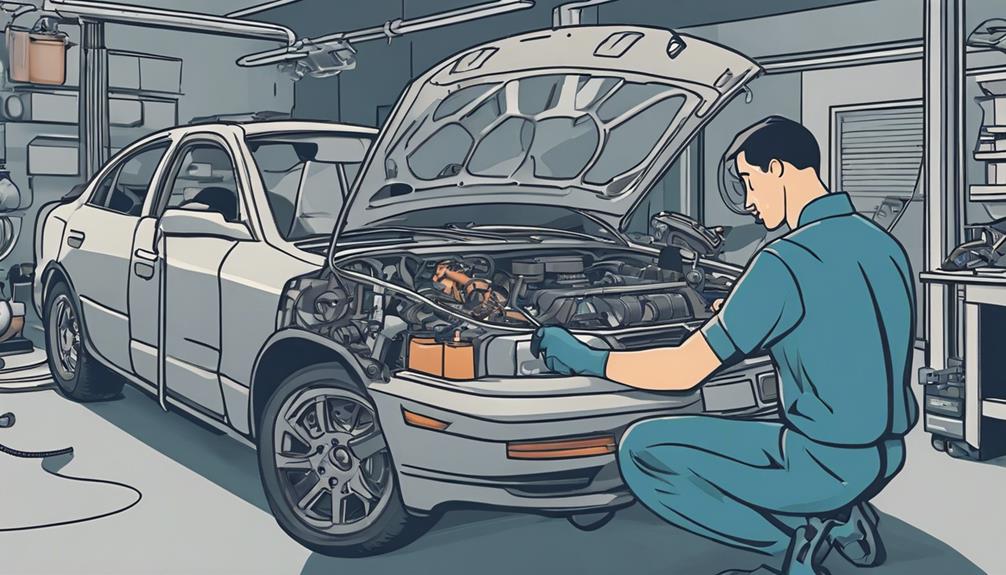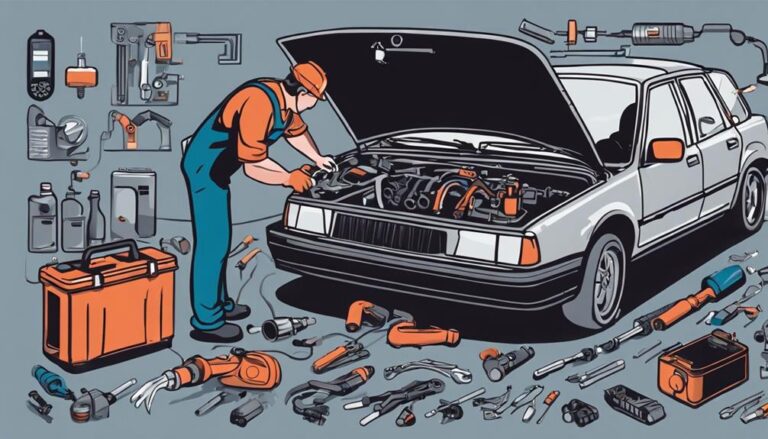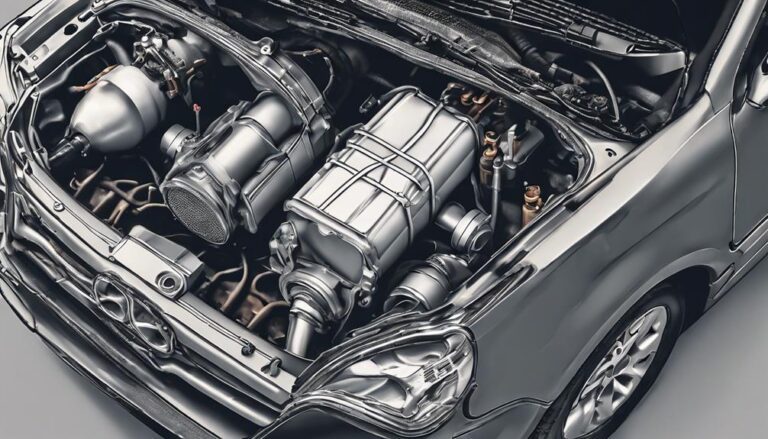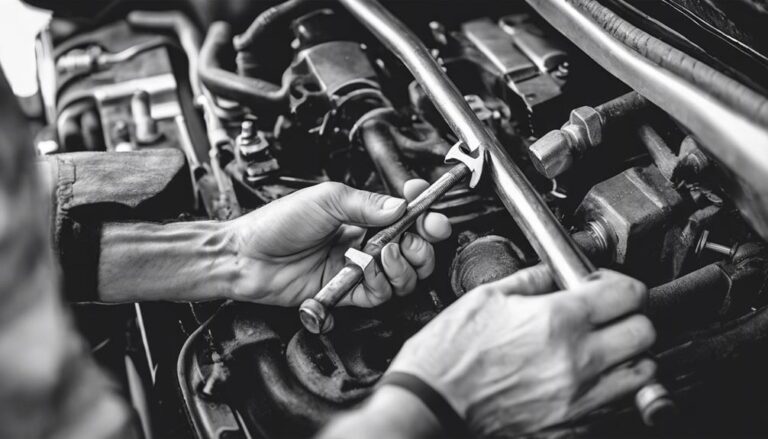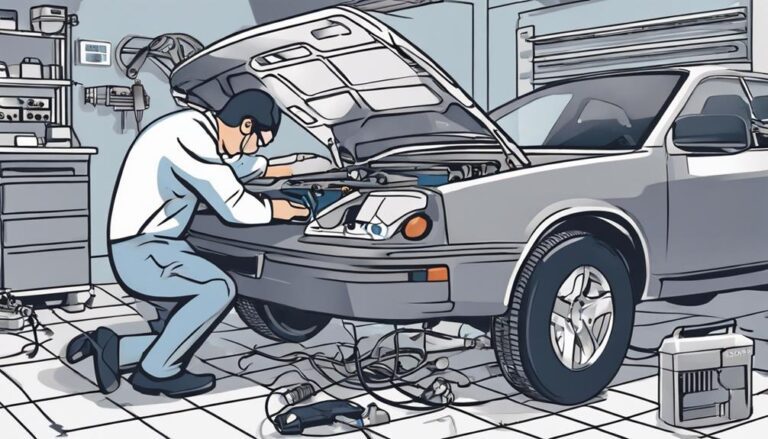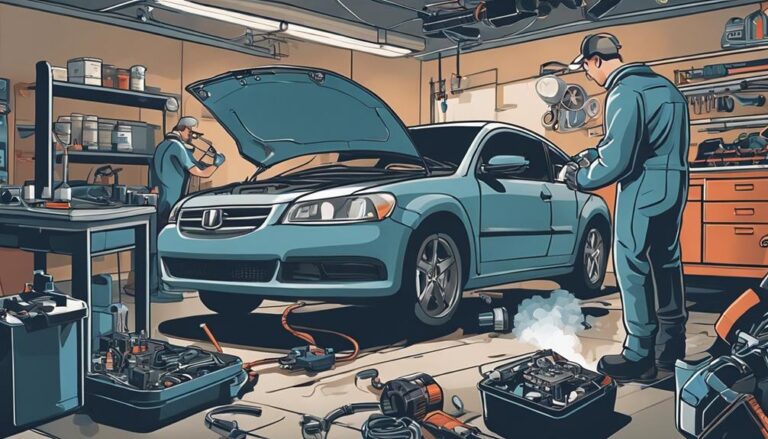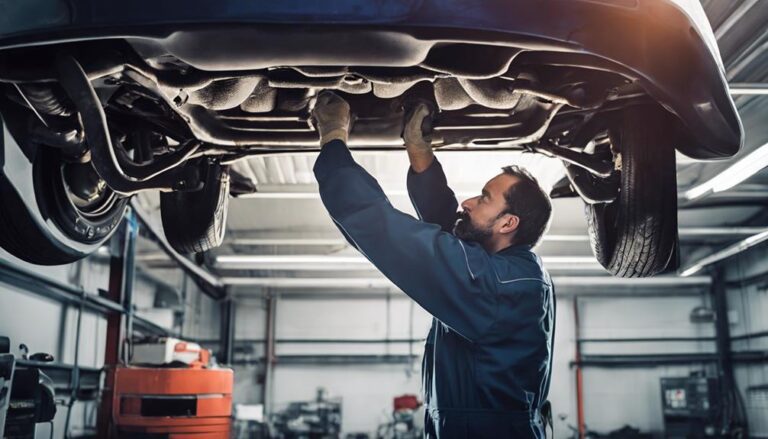Repairing Vs Replacing Your Emission System: 10 Tips
When pondering the predicament of repairing versus replacing your emission system, precision in decision-making is paramount.
As you navigate the intricacies of emissions maintenance, a dilemma arises: do you opt for a quick fix or a complete overhaul? Understanding the nuances of each choice and their implications could be the key to safeguarding your vehicle's performance and reducing environmental harm.
So, what factors sway the balance between repair and replacement? Stay tuned to uncover the ten essential tips that will illuminate your path to emission system enlightenment.
Key Takeaways
- Consider severity, cost, and environmental impact before deciding on repair or replacement.
- Seek expert advice to assess damage, cost-effectiveness, and make an informed decision.
- Evaluate performance, cost, and long-term savings to determine the most economical choice.
- Plan for future maintenance needs, consider warranties, and monitor emissions for environmental benefits.
Emission System Repair Vs. Replacement Overview
When facing emission system issues, determining whether to repair or replace components depends on the severity of the problem and potential cost savings. If your Check Engine light is on or you fail an emissions test, you likely have an emission system problem that needs attention. Minor issues like a faulty oxygen sensor or a loose gas cap can often be repaired, which is usually more cost-effective than replacing the entire system. However, major problems such as a damaged catalytic converter or extensive exhaust system leaks may require replacement.
To make an informed decision between repair and replacement, it's important to have diagnostic tests conducted by a mechanic. These tests can pinpoint the exact issue and help determine the best course of action. Repairing specific components can address isolated problems, while replacing the entire emission system may be necessary for more thorough issues affecting multiple parts. By properly diagnosing and evaluating the emission system problem, you can ensure top vehicle performance and emission control.
Consider the Age and Mileage
Considering the age and mileage of your vehicle is important when deciding whether to repair or replace the emission system components. Older vehicles with high mileage tend to experience more wear and tear on their emission systems, making replacement a more practical choice. On the other hand, repairing the emission system of a newer vehicle with low mileage might be a cost-effective solution. Here are four key points to keep in mind:
- Age and Mileage Impact: Older vehicles with high mileage are more likely to benefit from a full replacement of emission system components due to increased wear and tear.
- Cost-Effectiveness: Repairing the emission system of a newer vehicle with low mileage can be a more economical option compared to replacing it entirely.
- Overall Vehicle Condition: Consider the general condition of your vehicle to determine whether repairing or replacing the emission system is the better long-term choice.
- Availability of Parts: Finding replacement parts for older emission systems can be challenging, potentially making repairs more complicated and costly.
Evaluate Cost and Labor Involved
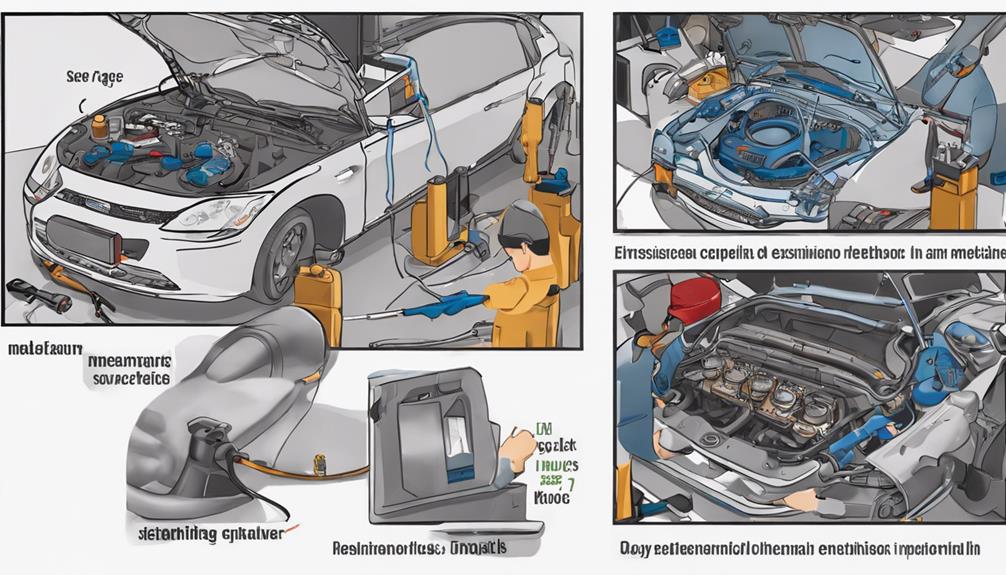
When deciding between repairing or replacing your emission system, you must analyze the costs and labor involved. Understanding the financial implications and time commitment of each option is essential in making an informed choice.
Consider the specific repairs needed and the expertise required to complete them efficiently.
Cost Analysis
To evaluate the overall expense, assess the cost of repairing emission components such as oxygen sensors, catalytic converters, and exhaust leaks, factoring in labor costs for diagnosing and fixing these issues.
When conducting a cost analysis for your emission system repair, consider the following:
- Compare repair part costs versus complete system replacement for cost-effectiveness.
- Factor in potential savings from improved fuel efficiency and performance post-repair or replacement.
- Consult with a mechanic for accurate cost estimates and recommendations.
- Understand the long-term benefits of investing in emission system repairs for your vehicle's efficiency and longevity.
Labor Considerations
Evaluating labor costs for repairing emission system components involves considering the mechanic's expertise, diagnostic and repair time, and the specific components needing attention to determine the overall cost efficiently.
Labor costs can vary depending on the complexity of the repair, ranging from $100 to $500 for components like oxygen sensors or catalytic converters. The mechanic's expertise plays a vital role in the accuracy and efficiency of the diagnostic process, impacting both time and cost.
Factors such as the vehicle make and model, component accessibility, and any unforeseen issues discovered during diagnostics can also influence labor expenses.
It's essential to weigh the cost of labor against parts when deciding between individual repairs and full system replacement for the best emission system performance and cost-effectiveness.
Assess the Severity of the Issue
Assess the severity of your emission system issue by considering key factors such as the age of your vehicle, the extent of damage, and the cost of potential repairs. To make an informed decision on whether to repair or replace your emission system, follow these steps:
- Severity Assessment: Determine if the emission system issue is minor or major by evaluating its impact on vehicle performance, emissions control, and safety.
- Vehicle Age: Older vehicles may have more worn-out components, making repairs less cost-effective in the long run.
- Extent of Damage: Assess the extent of damage to crucial emission system parts to gauge the repair feasibility.
- Repair Costs: Compare the cost of potential repairs to the expense of a replacement system to make a financially sound decision.
Consult With a Qualified Mechanic
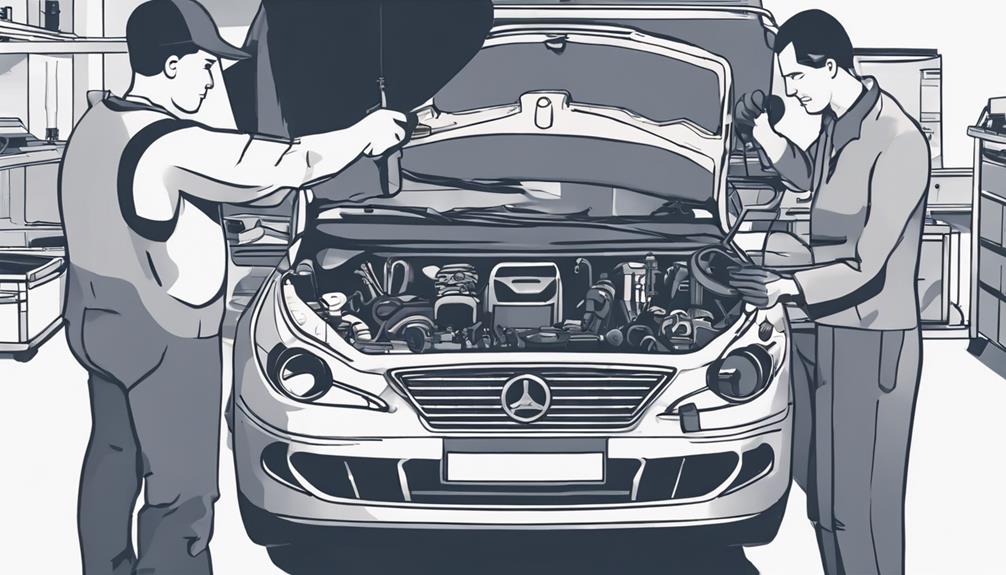
Before making a decision on repairing or replacing your emission system, seek advice from a qualified mechanic. Mechanics possess the expertise to evaluate the condition of important components and provide accurate diagnoses.
Consulting with a professional guarantees you receive the necessary guidance to determine the most cost-effective and efficient solution for your vehicle's emission system.
Expert Mechanic Advice
Seeking guidance from a qualified mechanic is crucial for making informed decisions regarding your emission system's repair or replacement. When it comes to expert mechanic advice:
- Mechanics can accurately diagnose emission system issues, pinpointing the exact cause of failures.
- Expert advice helps determine whether repairing or replacing emission system components is the most cost-effective solution.
- Professional guidance guarantees the proper handling of complex emission system problems, preventing further issues down the road.
- Trusting a mechanic's expertise can lead to efficient and long-lasting repairs for your emission system, giving you peace of mind about your vehicle's performance.
Professional Evaluation Needed
For an accurate evaluation of your vehicle's emission system, consulting with a qualified mechanic is imperative. A professional evaluation by a qualified mechanic is essential to diagnose any emission system issues correctly. This guarantees that the right components are addressed, preventing unnecessary costs. Expert advice from a mechanic can help you decide whether repairing or replacing parts of the emission system is the best course of action. Additionally, mechanics can provide cost estimates for both repair and replacement options, aiding in your financial planning. By consulting with a qualified mechanic, you can rest assured that your emission system functions at its best and meets environmental standards.
| Benefits of Professional Evaluation | |
|---|---|
| Accurate diagnosis of emission system issues | |
| Avoid unnecessary costs | |
| Informed decision-making | |
| Cost estimates for repair and replacement | |
| Ensuring emission system meets standards |
Determine Long-Term Benefits
Consider the overall cost-effectiveness and potential future savings when deciding between repairing or replacing emission system components for long-term benefits. Evaluating the long-term benefits of repairing versus replacing emission system components is vital in making an informed decision. Here are four key considerations to help you determine the long-term benefits:
- Cost-Efficiency: Calculate the total cost of repairing the emission system components compared to the cost of replacing them. Factor in potential future repairs or replacements to determine the most cost-effective option over time.
- Durability: Evaluate the durability of the repaired components versus new ones. Consider the longevity and reliability of both options to ensure sustained emission system functionality.
- Performance: Analyze how the repaired components may affect the overall performance of the emission system. Compare this with the performance of new components to determine the best long-term solution for your vehicle.
- Resale Value: Consider how repairing or replacing emission system components may impact the resale value of your vehicle. Opting for a more durable and reliable solution could potentially increase the resale value in the long run.
Factor in Environmental Impact

To make a well-informed decision regarding your emission system, evaluating the environmental impact of repairing versus replacing components is essential. Repairing emission system components can often be more environmentally friendly than replacing them. By opting for repairs, you can reduce waste from discarded parts and contribute to sustainability by extending the lifespan of existing components.
Properly repaired emission system parts also help maintain best emission control, which in turn reduces the release of harmful pollutants into the environment. When considering repair versus replacement, it's important to factor in the environmental impact of disposing of old parts.
Choosing repair over replacement aligns with eco-friendly practices, promoting a greener approach to vehicle maintenance. This decision not only benefits the environment by reducing manufacturing needs but also supports a more sustainable way of managing your emission system. Make a choice that's both practical for your vehicle and environmentally responsible by considering the impact of your decisions on emission system components.
Explore Warranty and Guarantee Options
When deciding between repairing or replacing your emission system, it's important to explore warranty and guarantee options.
Warranty coverage details can determine the extent of protection for your emission system components. Understanding guarantee benefits and comparing warranty options can help you make an informed choice to guarantee long-term reliability.
Warranty Coverage Details
Exploring warranty and guarantee options for your emission system can provide valuable insights into potential coverage extensions and repair considerations. When evaluating warranty coverage details for emission system repairs, keep the following points in mind:
- Varied Coverage: Warranty coverage for emission system repairs can vary widely among manufacturers, potentially extending up to 8 years or 80,000 miles.
- Component Specific: Some warranties specifically cover emissions-related components such as catalytic converters, oxygen sensors, and EGR valves.
- Extended Options: Extended warranties or emissions system guarantees may be available as add-on options for additional coverage beyond the standard warranty.
- Authorized Repairs: Warranty terms often mandate that repairs must be carried out by authorized dealers or certified mechanics to maintain coverage integrity.
Guarantee Benefits Explained
Considering warranty coverage details for your emission system repairs, now let's highlight the benefits of guarantees, specifically exploring warranty and guarantee options.
Warranty options range from standard manufacturer warranties to extended ones for emission system repairs. Guarantees offer coverage for specific components or services related to the emission system, giving drivers peace of mind. These guarantees can include coverage for parts, labor, and certain emission-related issues for a specified period, reducing repair costs.
Understanding the terms and conditions of the warranty is important in determining the best course of action for your vehicle. Guarantees play an important role in offsetting the expenses associated with emission system repairs and ensuring the proper functioning of your vehicle's emission components.
Comparison of Warranty Options
To make an informed decision between repairing or replacing your emission system, it's necessary to compare the various warranty options available, ranging from standard manufacturer warranties to extended ones. When exploring warranty options for emission system repairs, consider the following:
- Coverage Durations: Warranty options typically range from 1 year/12,000 miles to 5 years/unlimited miles.
- Extended Warranties: Extended warranties may cover parts and labor costs for emission system repairs beyond the manufacturer's warranty period.
- Additional Benefits: Some warranties offer perks like roadside assistance and rental car coverage during repairs.
- Varied Coverage: Warranty coverage may differ based on the specific components of the emission system being repaired or replaced.
Understanding these warranty options can assist you in determining the best course of action for your emission system needs.
Understand Maintenance Requirements
Understanding the maintenance requirements of your vehicle's emission system is important for ensuring its longevity and best performance. Regular maintenance of the emission system involves tasks such as replacing air filters, checking oxygen sensors, and inspecting the catalytic converter. Adhering to manufacturer recommendations for maintenance intervals is vital to guarantee best emission system performance. By providing proper care to your emission system, you can prevent costly repairs and enhance fuel efficiency. Timely maintenance also plays a significant role in detecting minor issues before they escalate into major problems. It is essential to grasp the specific maintenance requirements of each emission system component to maintain your vehicle's long-term health effectively.
| Maintenance Task | Description |
|---|---|
| Replace Air Filters | Ensures clean air intake for proper combustion. |
| Check Oxygen Sensors | Monitors oxygen levels in exhaust gases for efficient fuel combustion. |
| Inspect Catalytic Converter | Verifies proper functioning to reduce harmful emissions. |
| Follow Manufacturer Recommendations | Adhering to guidelines for best emission system performance. |
| Monitor Maintenance Intervals | Schedule regular checks to maintain emission system efficiency. |
Make an Informed Decision
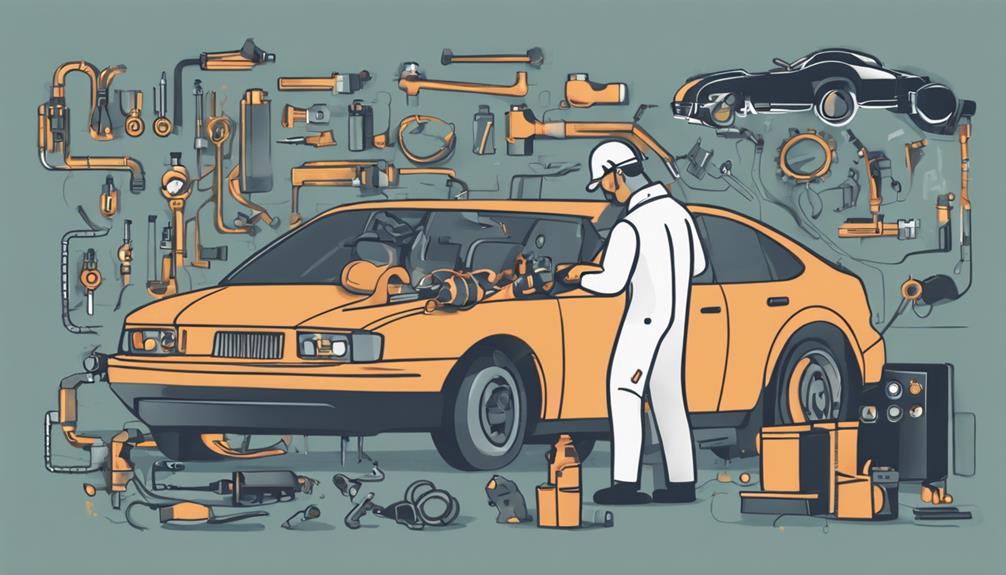
When making a decision between repairing or replacing your vehicle's emission system components, carefully assess the cost-effectiveness and long-term benefits to guarantee top performance and efficiency. Here are four essential tips to help you make an informed decision:
- Consider the cost-effectiveness: Evaluate the expenses associated with repairing oxygen sensors or catalytic converters versus the investment in replacing these vital components.
- Assess the age and condition of the vehicle: Determine if a complete replacement of the emission system would be more advantageous considering the overall state of your vehicle.
- Consult with a trusted mechanic: Seek expert advice to understand whether repairing or replacing the emission system would yield better results for your vehicle's performance and efficiency.
- Evaluate the impact on vehicle performance: Take into account how the decision between repair and replacement could affect your vehicle's performance, fuel efficiency, and environmental emissions.
Frequently Asked Questions
How Do You Fix an Emission System?
To fix an emission system, you need to diagnose issues like faulty sensors or leaks. Tighten or replace a damaged cap, clean dirty filters, and affirm proper sensor placement. Promptly addressing problems maintains efficiency and prevents damage.
How Much Does It Cost to Fix Check Emission System?
When fixing your emission system, costs vary based on the issue found by diagnostics. Opt for cost-effective repairs through prompt maintenance and professional help. Preventing major problems saves money in the long run. Be proactive.
How to Pass a VA Emissions Test?
To pass a VA emissions test, focus on emission system maintenance, troubleshooting, and upgrades. Make sure components like catalytic converters and oxygen sensors work correctly. Regular tune-ups and timely repairs can boost your chances of success.
What Does It Mean When Your Car Says Emission System Problem?
When your car displays 'Emission System Problem,' it indicates issues with parts like the catalytic converter or oxygen sensors. Ignoring this can hurt performance. Get a mechanic to scan and fix it promptly.
Conclusion
You've learned the importance of maintaining your emission system and the factors to contemplate when deciding between repair and replacement.
Did you know that a faulty emission system can decrease your vehicle's fuel efficiency by up to 30%?
Stay proactive in addressing issues promptly to save money and protect the environment.
Make informed decisions to keep your vehicle running smoothly and reduce harmful emissions.

